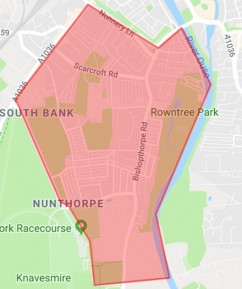Boozing, booze and boozers in our area
One of our members, Rob Stay, recently gave us a fascinating talk about the history of the pubs in our area, and has kindly provided us with his notes for our website.


View navigation
 This map shows how we agreed our area of interest, to indicate a locally defined area that does not intrude into areas chosen by nearby similar groups. Its boundaries largely run along the River Ouse or main roads. No part of the area lies or has ever lain within the defensive city walls of Roman or medieval York. That is very significant and while anyone now living in our area would rightly say they lived in York, that would be true only from fairly recent times. Development for housing in the area began in earnest in the early 19th century and was substantially complete by the 1930s. One part of the area was cleared and redeveloped in the 1960s. That lay along Nunnery Lane and was bounded at one end by Bishopthorpe Road. I refer several times to now long-lost streets that lay within that area.
This map shows how we agreed our area of interest, to indicate a locally defined area that does not intrude into areas chosen by nearby similar groups. Its boundaries largely run along the River Ouse or main roads. No part of the area lies or has ever lain within the defensive city walls of Roman or medieval York. That is very significant and while anyone now living in our area would rightly say they lived in York, that would be true only from fairly recent times. Development for housing in the area began in earnest in the early 19th century and was substantially complete by the 1930s. One part of the area was cleared and redeveloped in the 1960s. That lay along Nunnery Lane and was bounded at one end by Bishopthorpe Road. I refer several times to now long-lost streets that lay within that area.